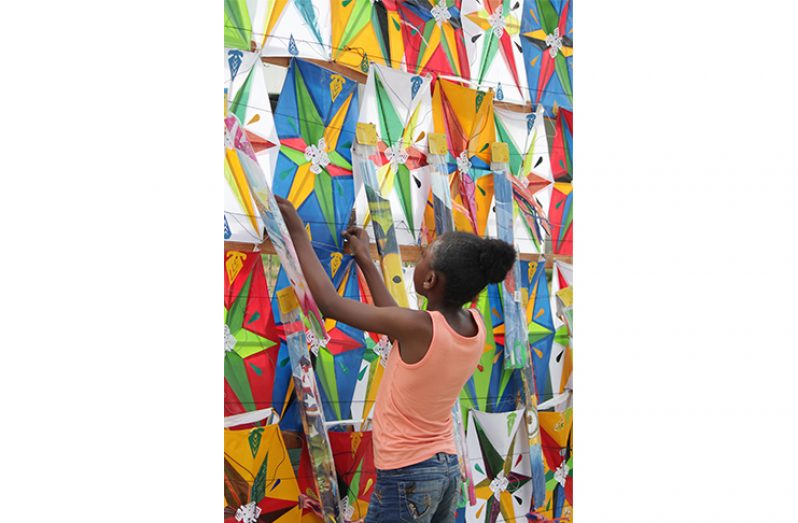Part and parcel of Easter in Guyana

EASTER is a widely celebrated holiday in Guyana, and kite-flying, perhaps, forms one of the largest parts of the celebrations. Each year, skilled kite makers and sellers begin preparing months in advance just so that they can offer up a wide selection of kites to the Guyanese populace.
“The energy level is high, it’s like you can feel we are encountering a vibrant Easter this year,” ‘Ras’ Trevor Smith shared with the Pepperpot recently.
For exactly 40 years, since he was just 16 years old, Ras has been making kites to sell on Easter day. You could say, that Ras is an expert in kites at Easter in Guyana because of the sheer number of years he has been involved in the business.
To be a good kite maker, according to Ras, you need to have three critical things: a natural love for making kites, a passion for putting together the best kite and an innate joy in seeing a completed kite that you know someone will love. He also shared that for him, kite-making has caused him to become a more disciplined and patient person.
“It’s hard work, but hard work brings honest pay and it goes to show that the mind is capable of creating, but it just needs to be applied,” Ras Smith said.

And though he has a little shop at home that generates income for him, for most of the year, Ras would be at home making kites. He just loves it that much.
This year he made about 1,300 kites and shared that he was expecting to sell off these early. And if you meet him, you would understand why he would say this. Aside from his neatly done wood kites, Ras’ love for kites is evident and infectious. It is because of people like Ras, there is no shortage of kites in the sky at Easter time.
Love for the profession
This love is shared by 34-year-old Ryan Naar. The man is a mason by profession, and though he has been swamped with his usual job, he has a special place in his heart for making kites.
He started making his kites in January this year but highlighted that he would usually begin making his kites in November. He started late this time around because he was preoccupied with his job as a mason, but it was better late than never for something he loves doing.
“It’s the same thing all the time. You see all kinds of people come and buy the kites… We don’t watch face,” he highlighted.
This year, he shared that sales have been a bit slower than usual, but said: “You just got to keep the faith and hope for better.”
Determined woman
Then there’s 54-year-old Dawn Drayton. As a young girl, Dawn would help her dad paste the kites. And eventually, she decided that this was a business she wanted to get involved in herself.

For Dawn, the Easter holiday is one which is being embraced by more persons nowadays, and not just Christians, as evidenced by the persons buying kites. But the downside to this, for her, is that as the holiday grew more popular, the kite-selling business became inundated.
“It used to have about 20 main sellers out here years ago and my father alone would sell out about 500 kites, but now more kites selling but the money splitting up among more people,” she Drayton said.
Nevertheless, for this Easter season, she has about 300 kites for sale at various locations in ‘town’- being sold by herself and her siblings.
“It does take about 15 minutes overall to make a kite- to paste is and so, and then you got the loop and the tail,” she said.
The woman related also that in more recent times, persons have begun taking an interest in the traditional handmade wooden kites once again.
“What I find is that when the bird kites first came, people would run and buy that cause it cheap but now people buying the wood kites again,” she said.
Back to basics
At the corner of Camp and Robb streets, Orville Mccurdy shared the same sentiments as Drayton.

“What you see happening is that people fall away from the local traditional kite and going for the (bird) kite because it a little cheaper,” he said and explained: “But some people understand that those bird kites ain’t got the fun like what these wood kites would have and you see now that people going back to these kites.”
He also opined that Easter these days is celebrated quite differently from when he was younger.
“Easter back them was real old school, people more concerned with like a show or a party, it’s not like Easter before and following tradition like kite-flying or going to the beach or so,” he noted.
Within his family, though, he spends a lot of the time selling kites, he ensures that on Good Friday and the latter half of Easter Monday, he finds the time to be with his family.
And making the kites each year is his way of keeping the traditions alive. This year, he has about 200 kites on sale. Among the kite sellers in Georgetown, this was a relatively low number, but Orville explained his reasoning for this.
“Based on the market, you would assess and then that’s how you would sell,” he explained, and continued: “And last year, that’s the amount that actually sold so I decide to go back with that same amount and have a little now.”
It is evident that while kite-making is a craft that those who are involved take great pride in, there is also an art in selling these kites too.

Know your market
For 52-year-old Audrey Daniels, there are certain times when you market your kites and you need to understand what kites people want more.
And she garnered this knowledge from selling kites annually for 16 years. In fact, over the past few years, she shared that she has bought and sold maybe about 400 kites each year.
But at the spot where she sells her kites, she also has her ‘drinks stand’ so when persons stop to marvel at the beauty of the kites she could convince them into getting something to drink or capture their attention when they stop to quench their thirst- whichever works!
Long live the bird kite
Aside from the litany of wooden kites being sold, Ehud Thomas was one who lined the pavement at the corner of Regent and Camp streets with his variety of bird kites.

“I does walk and sell [undergarments] normally, but at Christmas time I does invest in toys and at Easter time I does invest in kites,” Thomas related.
“Years ago, I used to sell the local (wood) kites, but I ain’t got patience for that no more so I does invest in different sizes of kites,” he said further.
Kite sales would be constant leading up to the holiday but most of his sales occur on Easter Monday. The reason for this, according to him, is that persons would take their children out to fly their kites on the days leading up to Easter but would often lose these kites. As such, on the holiday of itself, they would return to buy the kites again.
Each year, he has between 500 to 600 kites but this year he had a lot more due to the ones left over from last year. He vividly recalled that a “heavy rain” fell all afternoon on Easter Monday last year, and as such, many persons were not inclined to buy and fly the kites.




.jpg)









